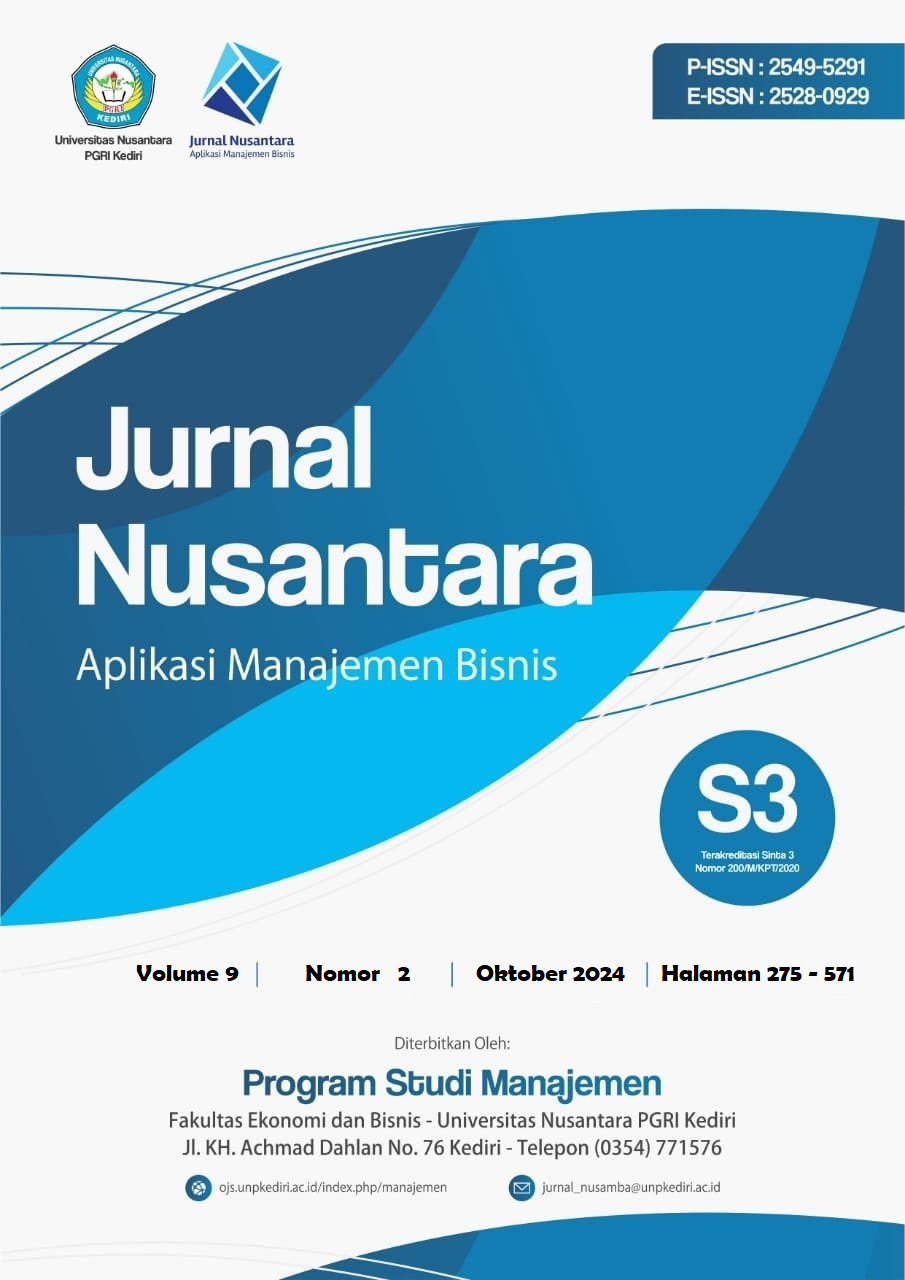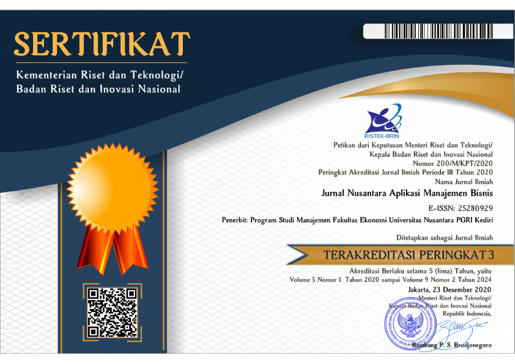Efisiensi Biaya Penugasan Karyawan Dengan Metode Hungarian : Studi Kasus pada Konveksi RAPPI
DOI:
https://doi.org/10.29407/nusamba.v9i2.22205Keywords:
Hungarian Method, Efficiency, Employee Assignment CostsAbstract
Research aim: This study aims to analyze the efficiency of employee assignment costs at Rappi Convection Company.
Design/Methode/Approach: The research design is descriptive qualitative. The analysis technique is the Hungarian method, which consists of 9 completion steps.
Research Finding : The results of this study indicate that by using the Hungarian Method, the Rappi convection company can save its employee assignment costs to Rp. 18,000 per piece of clothing.
Theoretical contribution/Originality : This research provides new insights and valuable information to improve production cost efficiency, especially in employee assignment costs.
Practitioner/Policy implication : The Hungarian method proves to be a very useful method in relation to production cost efficiency, especially in MSME-scale companies.
Research limitation : although the results showed cost efficiency after being calculated using the Hungarian method, this research still cannot cover the cost efficiency of other components so that further research must be carried out in order to increase production cost efficiency in the Rappi convection company.
Downloads
References
Firmansyah, P., & Alamsyah. A. (2020). Implementasi Metode Hungarian dalam Menentukan Keputusan Penambahan Karyawan pada UKM Puguh Jaya. Bulletin of Applied Industrial Engineering Theory, 1(1).
Gautama, I., Haryadi, S. ;, Robertus, S. ;, & Herman, T. (2013). PENERAPAN METODE HUNGARIAN PADA PERUSAHAAN JASA (KASUS MINIMUM). BINUS BUSINESS REVIEW, 4(2), 812–820.
Harini, D. (2017). Optimasi Penugasan Menggunakan Metode Hungarian. INTENSIF: Jurnal Ilmiah Penelitian Dan Penerapan Teknologi Sistem Informasi, 1(2), 68–74. https://doi.org/10.29407/INTENSIF.V1I2.797
Harini, D., & Informasi, S. (2017). Optimasi Penugasan Menggunakan Metode Hungarian Pada CV . L & J Express Malang ( Kasus Minimasi ). 1(2), 68–74.
Hia, O., Studi, P., Informatika, T., & Hungarian, A. (2019). Implementasi Metode Hungarian Dalam Penugasan Karyawan ( Studi Kasus : PT . Jefrindo Consultant ). 6(1), 85–92.
Indawan, Z. A. (2018). Prosiding Manajemen Analisis Penugasan Karyawan CV. Pratiwi Mandiri Bandung dengan Menggunakan Metode Hungarian untuk Mengoptimalkan Biaya Produksi. Prosiding Manajemen.
Kurnia, M., & Suseno, A. (2021). Optimasi Penugasan Menggunakan Metode Hungarian Pada UMKM XYZ, Riau. JURMATIS (Jurnal Manajemen Teknologi Dan Teknik Industri), 3(2), 103–116. https://doi.org/10.30737/JURMATIS.V3I2.1711
Muhtarulloh, F., & Novita, A. D. (2022). Solusi Optimal Masalah Penugasan Menggunakan Metode Alternatif Hungarian. Jurnal Sains Matematika Dan Statistika, 8(2), 156–164. https://doi.org/10.24014/JSMS.V8I2.19188
Mukhofilah, E. N., & Koesdiningsih, N. (2018). Analisis Penugasan Kerja dengan Metode Hungarian dalam Meminimumkan Biaya Produksi pada CV. Maika Mandiri Sejahtera Cimahi. Prosiding Manajemen SPESIA : Seminar Penelitian Sivitas Akademika Unisba, 0(0), 87–92. https://doi.org/10.29313/.V0I0.9031
Olo, D. L., Sikas, O. R., Bano, E. N., & Pembahasan, H. (2022). Optimasi Pembagian Tugas Karyawan Menggunakan Metode Hungarian Menentukan Penugasan optimum. 5(2622), 12–14.
Paendong, M., & Prang, J. D. (2011). OPTIMISASI PEMBAGIAN TUGAS KARYAWAN MENGGUNAKAN METODE HUNGARIAN. Jurnal Ilmiah Sains, 11(1), 109–115.
Rahmansyah, A., Rully, T., & Taurusyanti, D. (2019). Analisis Pengalokasian Tenaga Kerja dalam Meningkatkan Proses Produksi Pada PT. Kenlee Indonesia. Jurnal Online Mahasiswa (JOM) Bidang Manajemen, 4(2), 1–19.
Risqiati, Indrayanti, & Royanti. (2021). OPTIMASI PENUGASAN MENGGUNAKAN METODE HUNGARIAN DI PT HANA TEXT. IC-Tech : Journal of Informatics and Computer Technology, 16(2). https://doi.org/10.47775/ICTECH.V16I2.189
So, I. G., Sarjono, H., & Herman, R. T. (2013). Penerapan Metode Hungarian pada Perusahaan Jasa (Kasus Minimum). Binus Business Review, 4(2), 812–820. https://doi.org/10.21512/BBR.V4I2.1397
Downloads
Published
Issue
Section
License
Authors who publish with this journal agree to the following terms:
- Copyright on any article is retained by the author(s).
- The author grants the journal, the right of first publication with the work simultaneously licensed under a Creative Commons Attribution License that allows others to share the work with an acknowledgment of the work’s authorship and initial publication in this journal.
- Authors are able to enter into separate, additional contractual arrangements for the non-exclusive distribution of the journal’s published version of the work (e.g., post it to an institutional repository or publish it in a book), with an acknowledgment of its initial publication in this journal.
- Authors are permitted and encouraged to post their work online (e.g., in institutional repositories or on their website) prior to and during the submission process, as it can lead to productive exchanges, as well as earlier and greater citation of published work.
- The article and any associated published material is distributed under the Creative Commons Attribution-ShareAlike 4.0 International License












